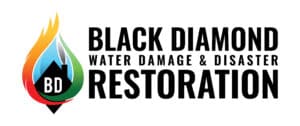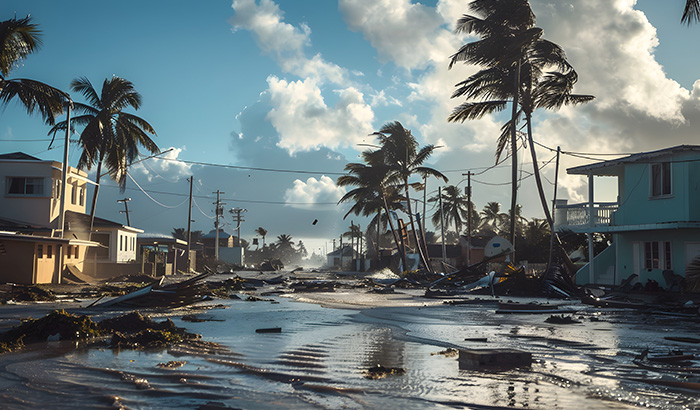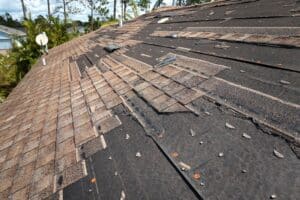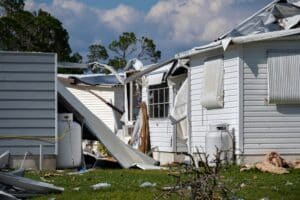It cannot be overstated how essential emergency storm preparedness is when it comes to facing nature’s unpredictable forces.
Storms often hit without warning and cause severe damage to those unprepared. That’s why investing time in emergency storm preparedness is crucial for safeguarding you and your loved ones’ safety. With a bit of preparation and the right know-how, you’ll be able to weather any storm that comes your way.
Let’s dive into the ultimate emergency storm preparedness checklist. This guide has you covered whether you’re a seasoned storm chaser or a novice to the tempest game.
Common types of storms
The first step of emergency storm preparedness is familiarizing yourself with the different types of storms. Understanding the nature of each storm will help you anticipate the challenges they bring and allow you to tailor your storm preparedness checklist accordingly. Knowing what you’re up against is half the battle in keeping you and your loved ones safe.
Hurricanes and tropical storms
Hurricanes and tropical storms are Goliaths in the weather world. These storms last for hours or even days. These powerful forces form over warm ocean waters and gain strength and size as they move. Hurricanes uproot trees, demolish buildings, and turn everyday objects into threatening projectiles, boasting winds that exceed 150 miles per hour.
In addition to fierce winds, hurricanes and tropical storms bring torrential rain that leads to severe flooding. The coastal areas are especially vulnerable, with storm surges pushing seawater onto land, resulting in significant property damage and loss of life.
Proper preparation for hurricanes and tropical storms makes all the difference. Follow evacuation plans and make sure your home is fortified against high winds and flooding. Also, stock up on emergency supplies, secure all outdoor items, and stay informed through weather updates. Storm damage remediation requires coordinated efforts between local authorities, emergency services, and community members to rebuild what was lost.
Tornadoes
Tornadoes are violent rotating columns of air that extend from thunderstorms in the sky all the way to the ground. Their wild forces are capable of causing massive destruction in a matter of minutes. Twisters, often depicted by their funnel-shaped clouds, have winds exceeding up to 200 miles per hour that easily tear through buildings, uproot trees, and hurl debris with deadly force.
Tornadoes often develop rapidly and offer little time for warning, making them particularly dangerous. In the United States, tornadoes are most common along “tornado alley” — a tornado-prone area which encompasses much of northern Texas up through Oklahoma, Kansas, Missouri and parts of Louisiana, Iowa, Nebraska and Colorado.
The key to surviving a tornado is having a plan and acting hastily. Designate a safe room or storm shelter in your home, such as a basement or a room on the lowest floor with no windows. Regular tornado drills will help everyone know where to go and what to do when a tornado warning is issued.
After the tornado passes, be cautious of hazards like downed power lines, harmful wreckage, and structural damage. Recovery involves assessing the damage, clearing all debris, and any necessary rebuilding efforts.
Thunderstorms
Thunderstorms highly vary in intensity. They bring heavy rain, thunder, lightning, hail, high winds, or a combination of all five. These storms occur almost anywhere and are quite dangerous if you’re caught unprepared.
Lightning strikes pose a significant risk, in particular. They’re capable of causing fires, power outages, and serious injuries or fatalities. Heavy rainfall frequently leads to flash flooding, particularly in urban areas with poor drainage. And hailstones threaten vehicles, roofs, and crops with their unforgiving aim.
Preparation for thunderstorms involves keeping informed about weather conditions and having a plan to seek shelter quickly when one hits. During a storm, always avoid using electrical appliances, as lightning can travel through wiring. Staying indoors and away from windows will protect you from flying debris and shattered glass.
Winter storms
Winter storms are synonymous with snow, ice, and freezing rain — all of which often lead to lengthy power outages, dangerous road conditions, and extreme cold. These storms make travel hazardous and sometimes impossible as they blanket entire regions in a layer of snow and ice. Ice storms are particularly devastating as they coat everything in a thick layer of deadly ice. The extreme cold that accompanies these storms also poses serious health risks, including frostbite and hypothermia.
Preparation for winter storms involves much more than just bundling up on a chilly day. Confirm your home is well-insulated and that you have an adequate supply of heating fuel. Stock up on food, water, and emergency supplies to help you stay safe and comfortable if you’re snowed in. Winterize your vehicles with emergency kits that include blankets, food, water, and a shovel.
Floods
Flooding happens when water overflows onto land that is usually dry. This natural disaster is the second most common globally, and all 50 states in the U.S. are at risk. Floods are triggered by heavy rainstorms, rapid snowmelt, overflowing ocean waves, river runoff, dam breaks, and other situations.
Some floods develop slowly, which gives forecasters the ability to predict their occurrence days or even weeks in advance. Flash floods, however, strike within minutes or hours without much warning. Floods may be brief and intense or persist for days, weeks, or even months. Given the unpredictability of flood timing and severity, being well-prepared is the best way to guarantee peace of mind.
Flood prep involves knowing your area’s flood risk and having an evacuation plan in place. Keep important documents in waterproof containers, and stock up on a supply of sandbags to help keep water out of your home. After the waters recede, storm damage remediation involves removing water and mud, mold prevention, and repairing structural damage.
The ultimate storm preparedness checklist: before the storm
- Create a family emergency plan
First and foremost, get everyone in your household on the same page with a rock-solid emergency plan. Discuss how you will communicate during the storm if phone lines go down and designate a meeting place if you become separated.
Assign responsibilities to each family member — who will grab the emergency kit, who will handle the pets, who will secure the home etc. Review and practice this plan often so that when the time comes, everyone knows exactly what to do.
- Build an emergency storm preparedness kit
Next, it’s time to put together a proper emergency storm preparedness kit. Your kit, often called a 72-hour kit, should include enough supplies to last at least 72 hours. Stock up on water (one gallon per person per day) and non-perishable food items like dried fruit and granola bars.
Don’t forget to include a first aid kit with bandages, antiseptics, and medications. Equip your kit with flashlights and extra batteries. Include personal hygiene items, warm clothing, sturdy shoes, and rain gear as well. Keep important documents, cash, and special needs items (baby supplies, pet food, etc.) in your kit as well.
- Secure your home
Take the necessary precautions to secure your home before any storm hits. This involves installing storm shutters or boarding up windows, making sure doors are securely fastened, and checking your roof for loose tiles or shingles.
Bring in or secure outdoor furniture, bikes, and any other outdoor items that could become projectiles in high winds. If you have a generator, make sure it’s ready to roll and have fuel on hand. You should also trim tree branches that could fall on your house or nearby power lines.
- Stay informed
Staying informed is the best way to keep yourself safe as a storm approaches. Sign up for local weather alerts on your phone and download reliable weather apps for real-time updates. Tune into local news stations for the latest information. They’ll let you know if it’s best to evacuate or stay put.
- Establish an evacuation plan
Evacuation becomes necessary in severe storms. Establishing a clear evacuation plan will help ensure a smooth and safe departure. Identify multiple evacuation routes from your home and familiarize yourself with each option. Keep maps handy in case GPS systems fail. Make sure your vehicle is in working order and always keep it filled with gas during storm season. If you have pets, make sure they are included in your evacuation plans as well.
During the storm
During the storm, hunker down indoors to stay safe from fierce winds and projectile fragments. Locate your emergency kit for all your essentials — food, water, and first aid supplies will keep you comfortable and secure. Keep electrical safety top of mind by unplugging gadgets you don’t need. If flooding starts, head for higher ground and steer clear of the floodwater. Stay smart and safe until the storm passes.
After the storm
The first thing to do post-storm is to assess the damage around your home, but exercise caution as you do so — avoid any downed power lines and don’t mess with any unstable structures. Begin the cleanup process by removing debris and salvaging what you can.
For extensive damage, contact storm damage remediation professionals to handle repairs and restore safety again. Reach out to your insurance company to report the damage and seek financial assistance as well. Amid all this, don’t forget to take care of yourself, too — rest, stay hydrated, and seek personal and professional support if you’re feeling overwhelmed.
Pet safety
Pets are family too, so don’t forget to include them in your emergency storm preparedness plan. Start by assembling a pet emergency kit that includes at least three days’ worth of food and water, any medications, a copy of their medical records, and some comfort items like favorite toys, blankets, and a carrier. These items will help your pets remain comfortable and cared for during an unsettling time.
Make sure your pets also have up-to-date identification tags and are microchipped to increase the chances of a safe reunion if you become separated. Create a safe, comfortable indoor space for your pets for them to stay during the storm. Consider using calming sprays or treats to help alleviate any anxiety your pets may experience during the storm’s noise and chaos.
By taking these proactive steps, you’ll help your furry friends stay safe and secure no matter what the weather brings.
Black Diamond Restoration is your key to storm damage remediation
When storms wreak havoc, robust emergency storm preparedness plans are essential. For all your storm damage needs, trust Black Diamond Restoration to be your reliable source for recovery.
Our wide range of services and dedication to excellence ensure that we help communities rebuild and recover from the devastating impacts of natural disasters. Our licensed professionals will guide you through the restoration process and bring your home or commercial space back to peak condition.
We’re here for you 24/7. Based in Murray, Utah, we proudly serve Salt Lake City and the surrounding areas. With over 20 years of disaster restoration experience, we handle it all and do it right! Contact Black Diamond Restoration today to learn more about our services today.
toto slot






